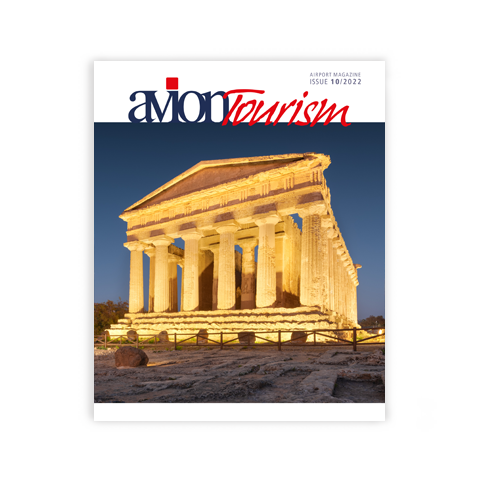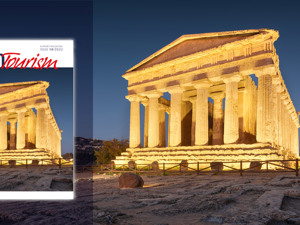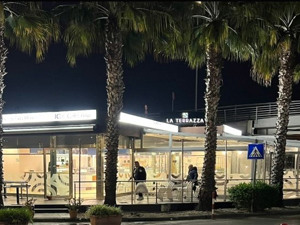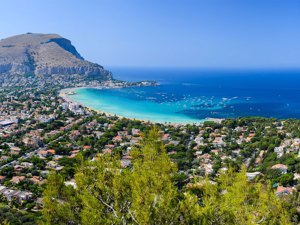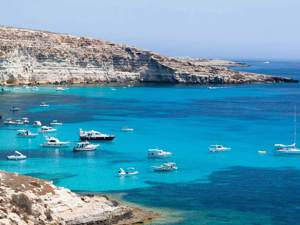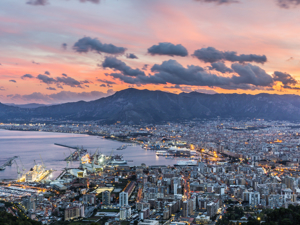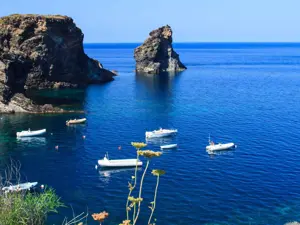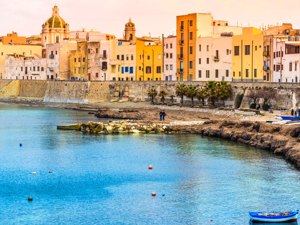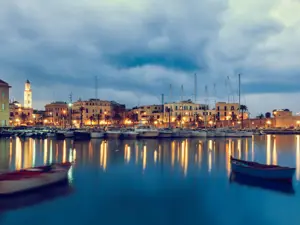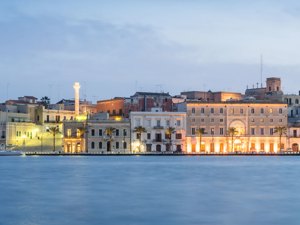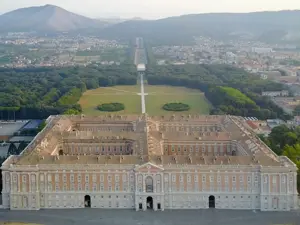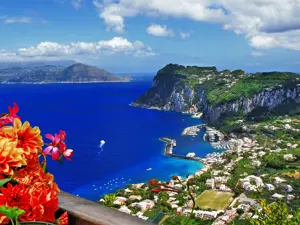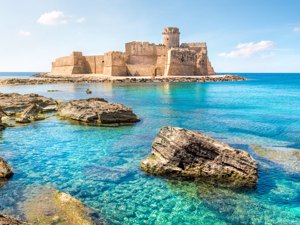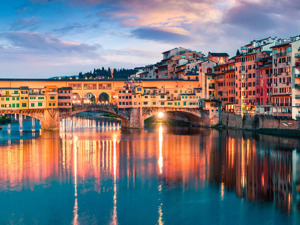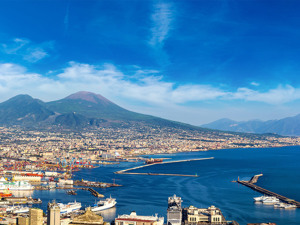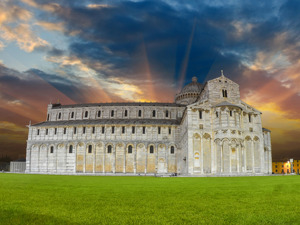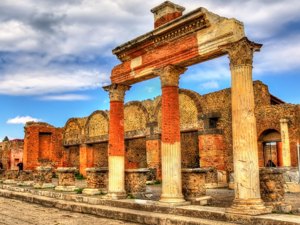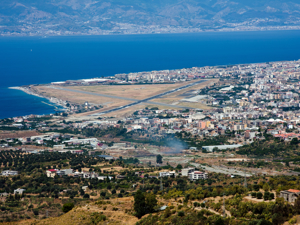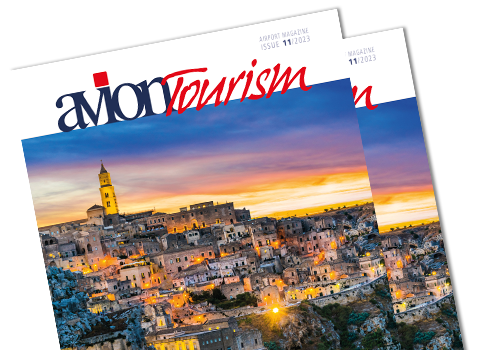The queen of Baroque
Catania is the Baroque queen of the Ionian Sea. It has an eighteen-century architectural layout, but its origins date back to the ancient Greek colony of the Chalcis people of Naxos, who settled on the slopes of Etna in 729 BC. Under Frederick II, Catania gained its first municipal coat of arms depicting the legendary elephant, which is still a symbol of the city today.
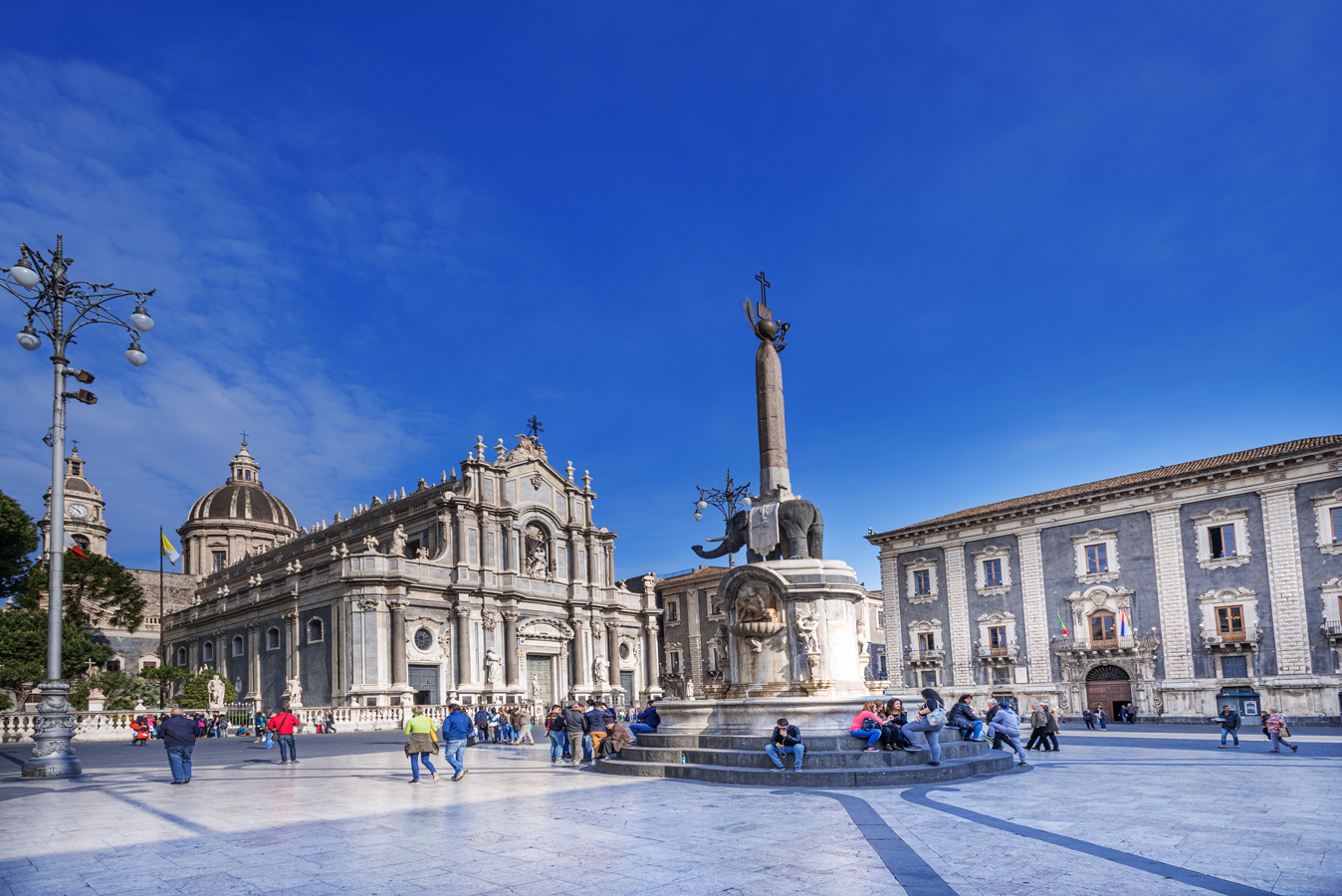
Cathedral of Catania. Photo: Copyright © Sisterscom.com / Nanisimova / Shutterstock
After Frederick II it was the turn of the Angevins and then the Aragonese, who made Catania capital of the Kingdom of Sicily and remained until 1411. The Spanish rule of Charles V brought about the construction of the outer defensive walls of the city, which are still visible along Via Plebiscito.
The tragedy of the eruption of Mount Etna in 1669 was followed by the serious consequences of the earthquake of 1693, which caused the almost total destruction of the city and the death of most of its inhabitants. The only buildings that remained standing were the apse of the Cathedral, the Castello Ursino and a few houses. Reconstruction, which was carried out rapidly, gave the city the urban appearance it has today.
Access to the city of Catania from the sea
Access to the city of Catania from the sea was through Porta Uzeda, built in 1696 in honour of the Viceroy. The gate unites the Seminario dei Chierici with the Cathedral, which was built between 1730 and 1758 by G. B. Vaccarini, and to which belongs the adjacent Fontana dell’Elefante (Fountain of the Elephant) (1735-1736). This fountain sits in the same square as the Palazzo Senatorio (Senate Palace). Today the seat of the city council, the palace was built between 1695 and 1780 by three architects, including Vaccarini.
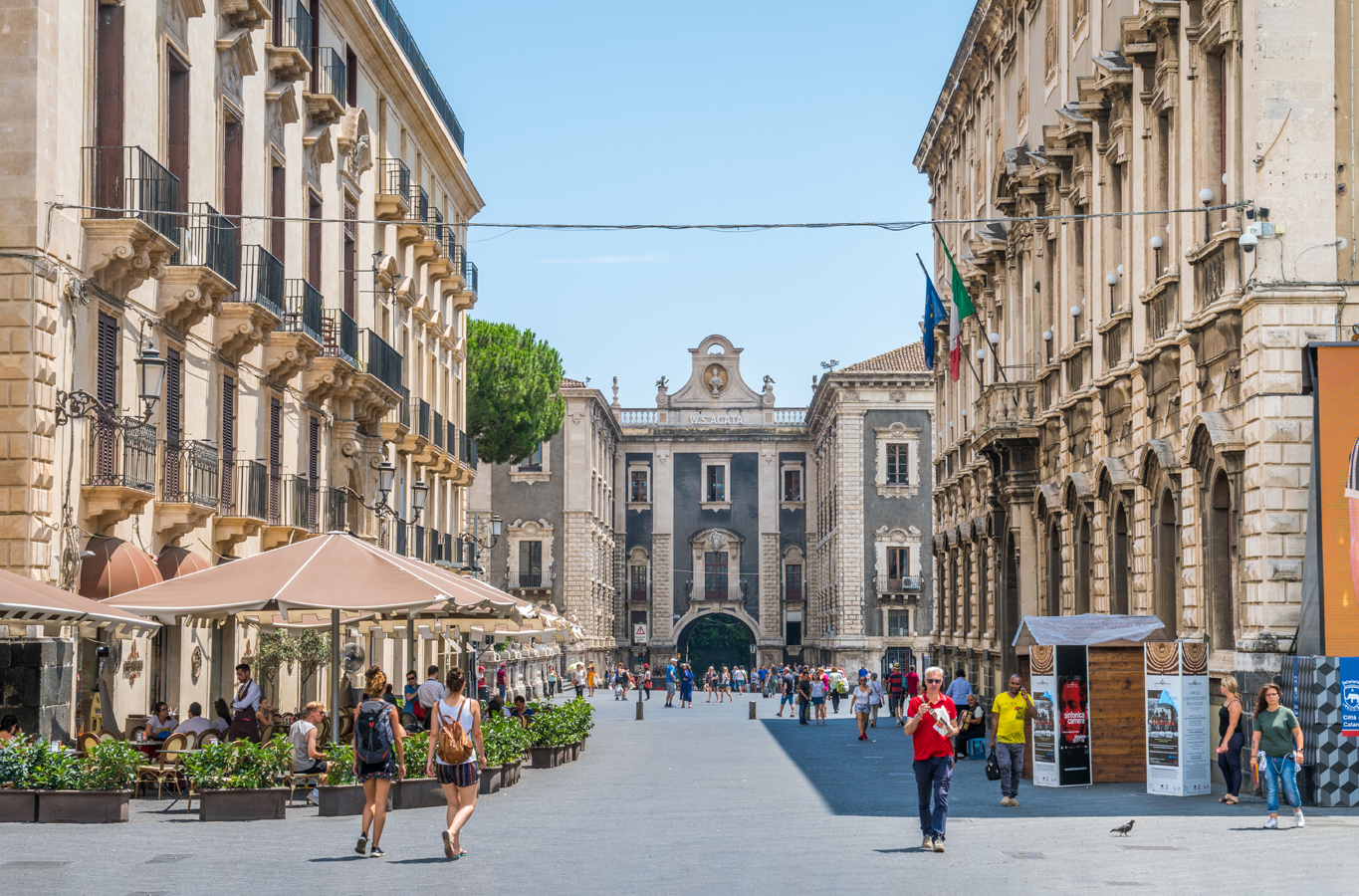
Porta Uzeda. Photo: Copyright © Sisterscom / Stefano_Valeri / Shutterstock
Massimo Bellini Theatre
Major opera artists have sung at the Massimo Bellini Theatre of Catania, including Toti Dal Monte, Maria Caniglia, Magda Olivero, Ferruccio Tagliavini, Beniamino Gigli, Tito Schipa, Ebe Stignani, Maria Callas, Mario Del Monaco, Giuseppe Di Stefano, Renata Scotto and Montserrat Caballé.
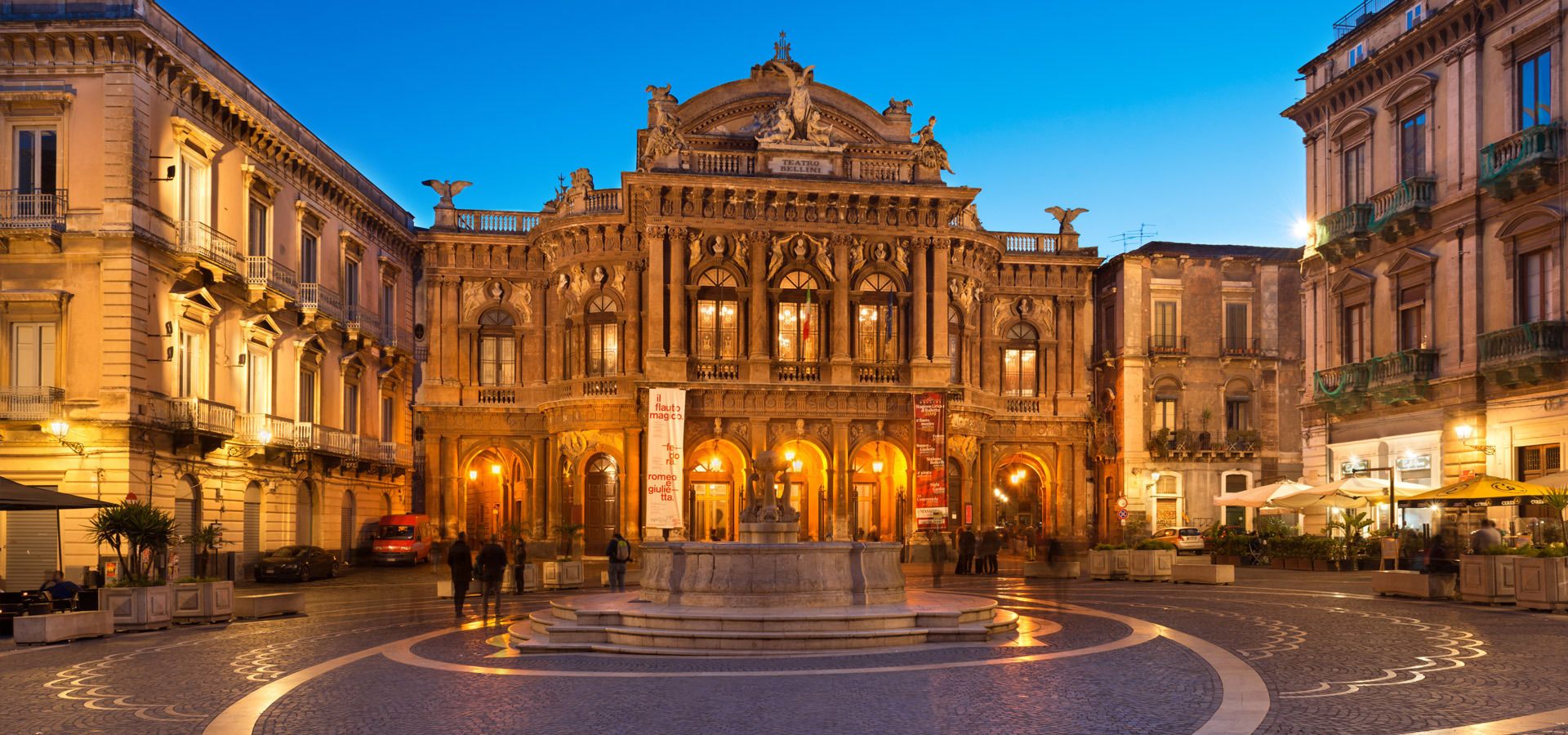
Teatro Bellini. Photo: Copyright © Sisterscom.com / Rsphotograph / Shutterstock
The churches of Catania
The Church of S. Placido, behind the cathedral was instead the work of the Roman architect Stefano Ittar, as was the concave facade of the Collegiata on Via Etnea.
A pinnacle of artistic skill, the Church of S. Giuliano in Via Crociferi is a masterpiece of eighteenth-century religious architecture with a curved facade and elliptical plan inspired by Borromini.
The Benedictine Convent of S. Nicolò is the most exclusive work among the collection of Baroque architecture in Catania.
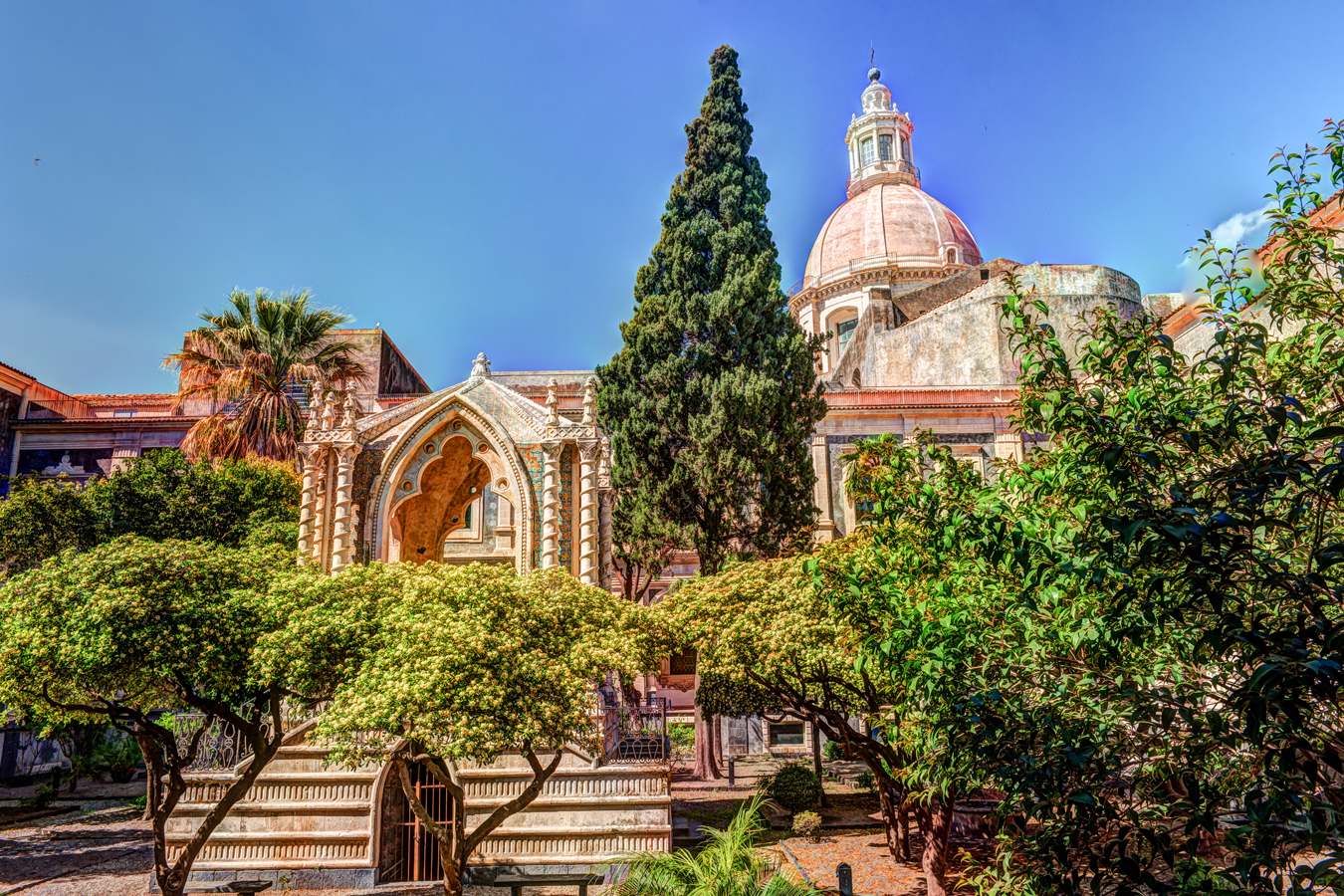
Benedictine Convent of S. Nicolò. Photo: Copyright © Sisterscom / Shutterstock
The historical palace in Catania
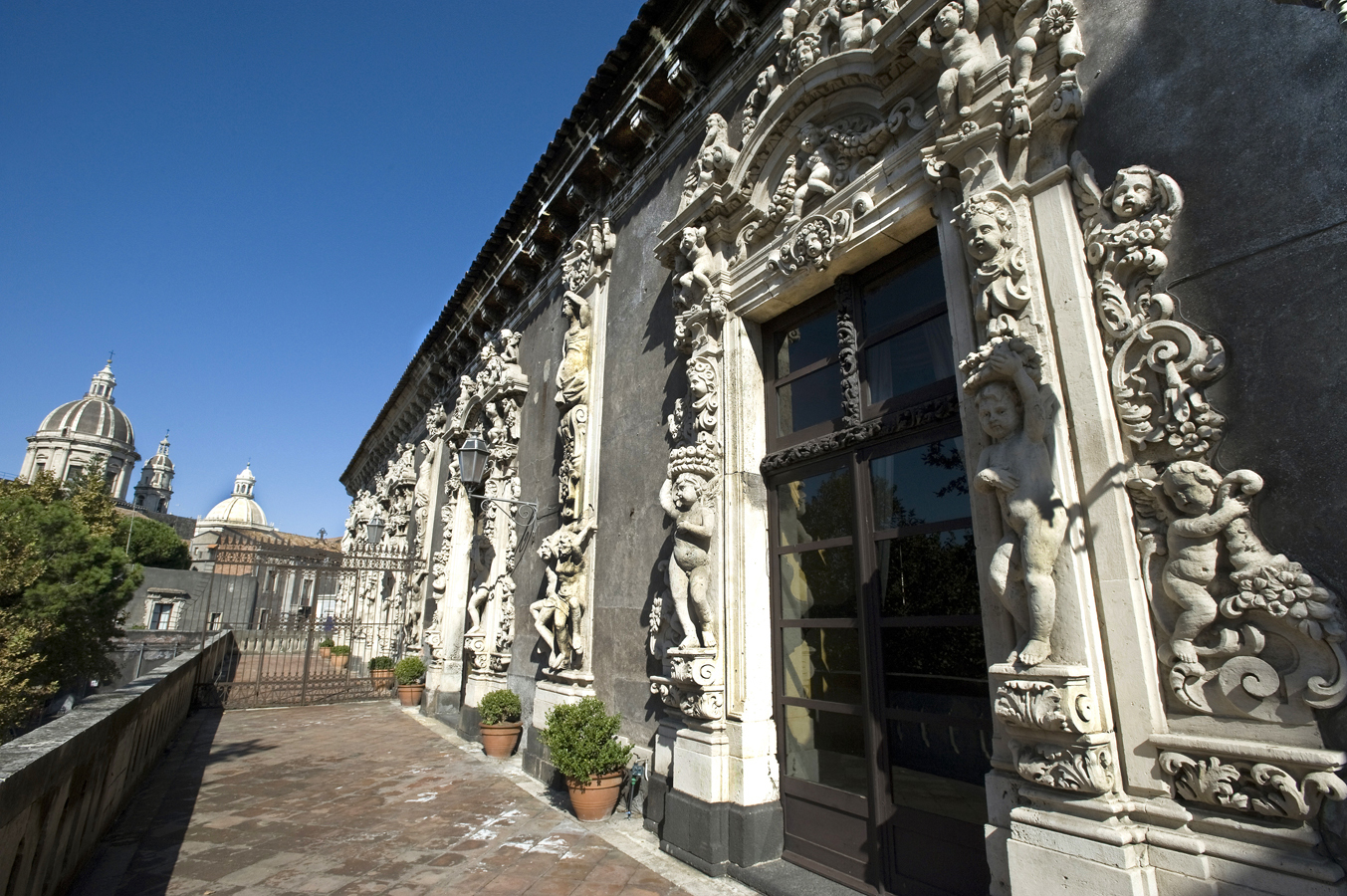
Palazzo Biscari. Photo: Copyright © Sisterscom / Shutterstock
Palazzo Biscari is instead a gem of eighteenth-century secular architecture, beautifully made with a ballroom and Rococo staircase.
Ursino Castle
Ursino Castle, built by Frederick II of Swabia between 1239 and 1250, houses the Civic Museum of Catania, which displays collections such as those of the Prince of Biscari, Baron Zappalà-Asmundo and the Benedictine Fathers. Works by Bernazzo, Bernardino Niger, Travi, Minniti, Stomer, Novelli, Rapisardi and the “Madonna with Child” by Antonello da Saliba (1466-1535) are of particular interest. The internal courtyard houses sarcophagi, columns, architectural fragments and obelisks recovered from Catania’s ancient monuments.
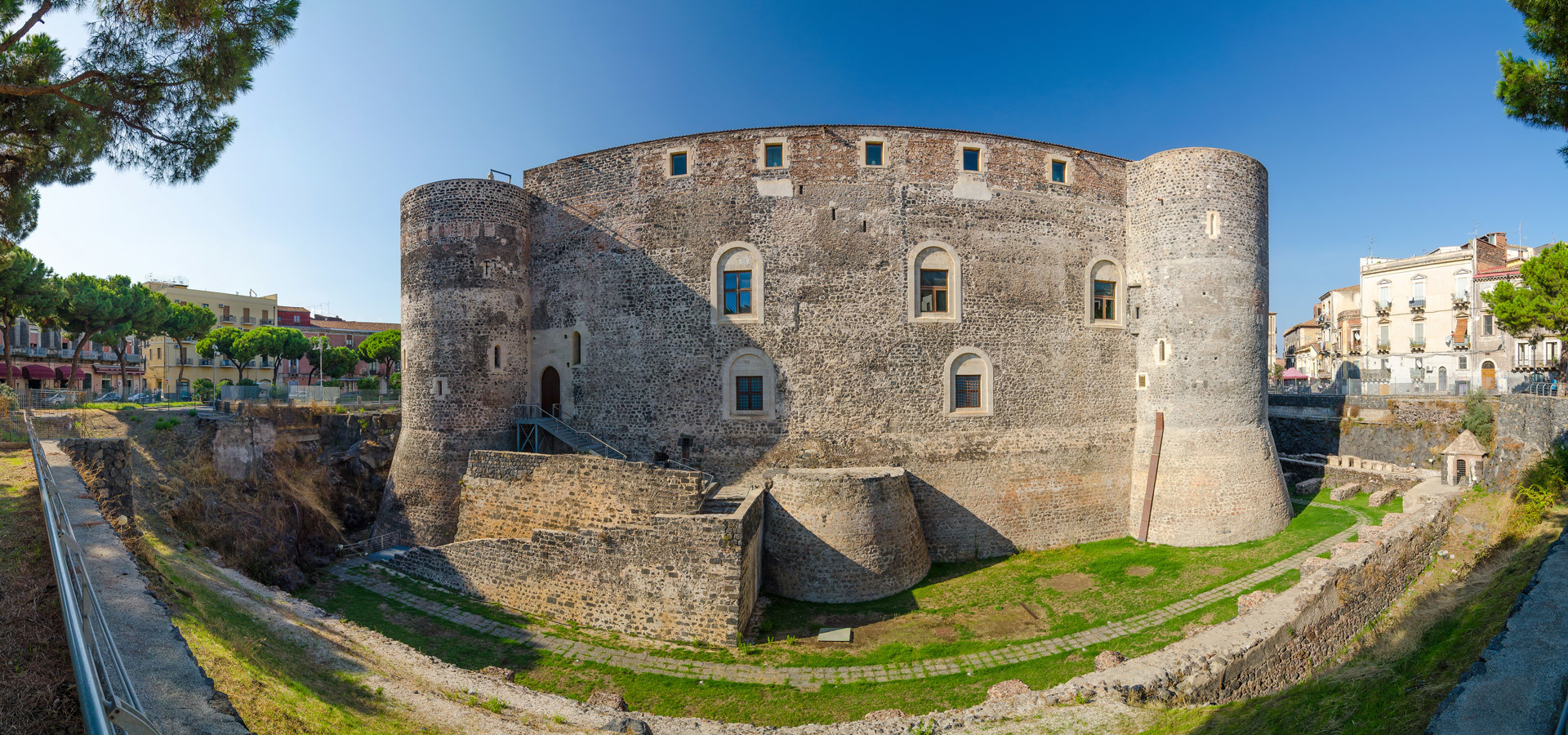
Castello Ursino. Photo: Copyright © Sisterscom.com / Yury Dmitrienko / Shutterstock
The promenade of Catania
The sea front promenade begins in Piazza dei Martiri, home of the Obelisco di S. Agata (Obelisk of St. Agatha) who crushed the snake, and ends in the Central Station. In the direction of the , after Piazza Borsellino, a golden beach extends beyond the Oasi del Simeto (a nature reserve with natural lakes and bays protecting migratory and resident birds) to the village of Agnone Bagni at the edge of the town of Lentini.
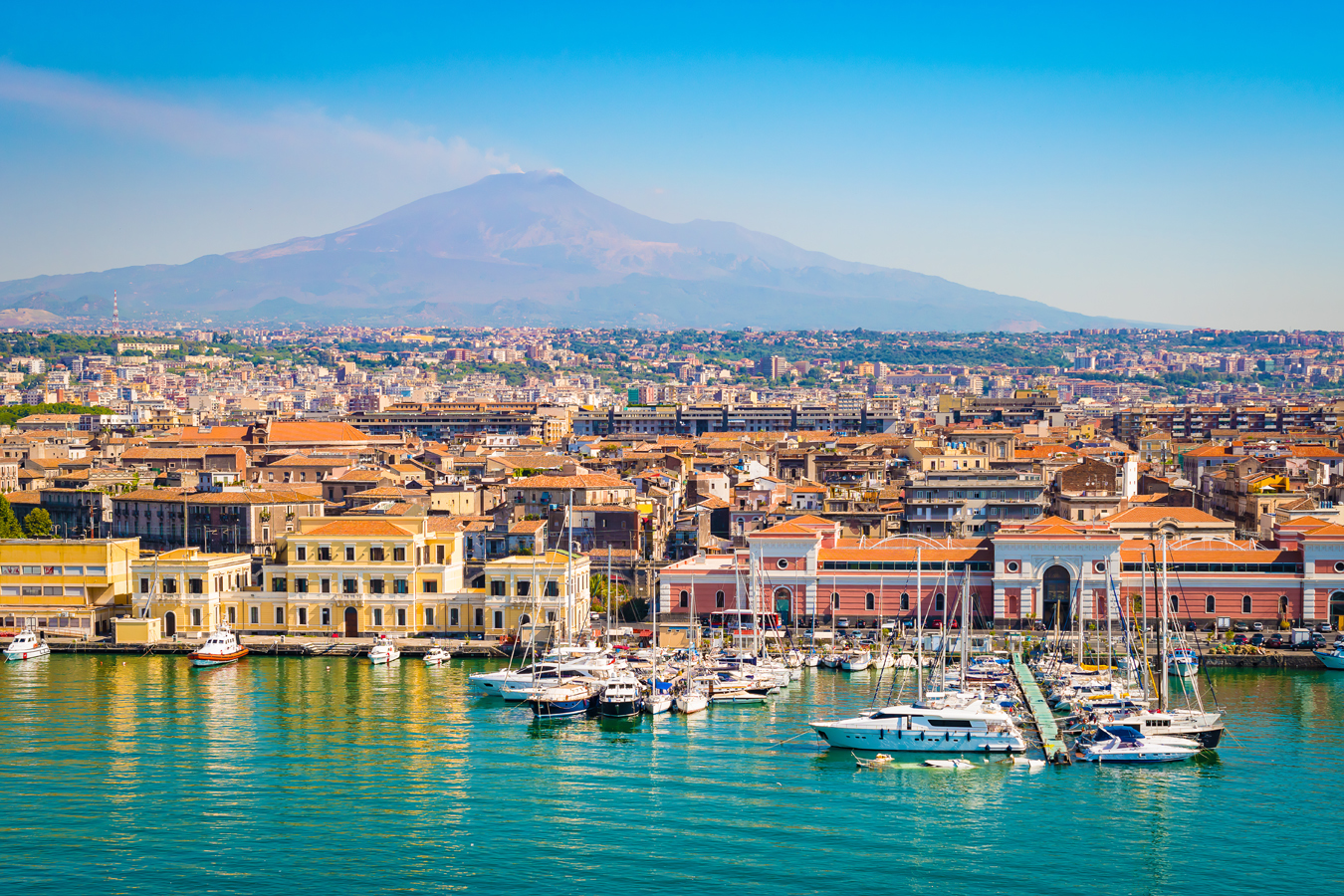
Porto of Catania. Photo: Copyright © Sisterscom / Shutterstock
The coastline of Catania offers unspoilt landscapes with expanses of sand and dunes and a crystal-clear sea.The last section of beach is studded with private and free sections and holiday villages. Behind this lies an extensive green area of pines, the Boschetto della Plaja (Beach Forest), where the fishermen’s village of S. Giovanni li Cuti is situated, with its small beach of black sand and lava stones among the rocks.
Village of Ognina and Acicastello
Further ahead lies the quaint fishermen’s village of Ognina, with its port, church dedicated to Mary Child and a small maritime museum.
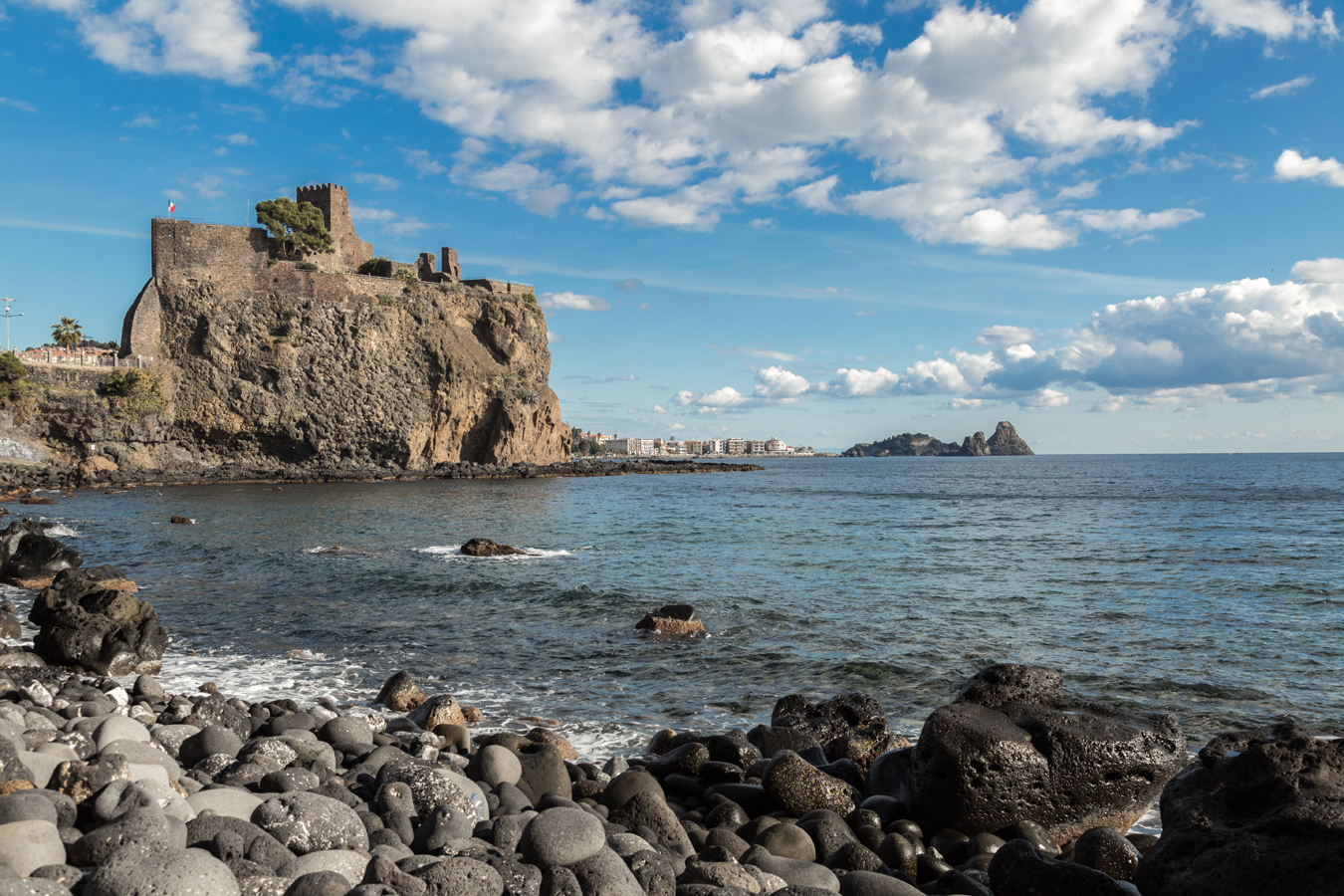
Medieval Castle of Acicastello. Photo: Copyright © Sisterscom / Shutterstock
From the village of Ognina, the residential area begins, with private homes and beach resorts that at night turn into disco bars. The cliffs end in the town of Acicastello with its Medieval Castle, which is located on an ancient lava rock that emerges from the sea. The cliff extends for approximately 30 km along the Riviera to Fiumefreddo, from where you can see Taormina.
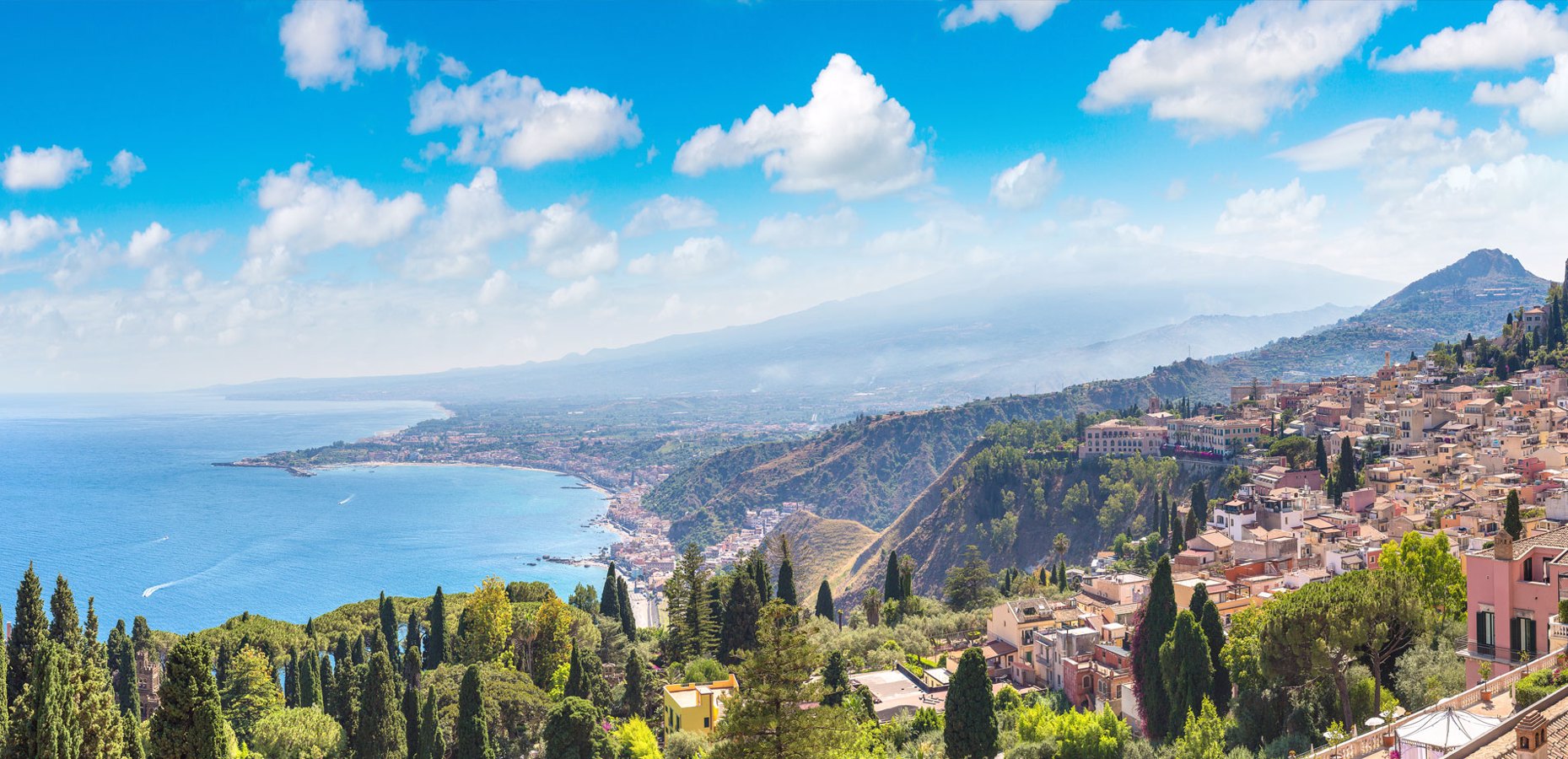
The promenade of Catania from above. Photo: Copyright © Sisterscom / Shutterstock
Shopping in Catania
Catania is known throughout Europe as one of Italy’s most lively cities for entertainment. It is a fun city at any hour of the day thanks to its craft workshops, shops and open-air markets. One of the trendiest areas at night is the old district, between Piazza Duomo, Piazza Università and Piazza Teatro Massimo, an excellent example of Baroque style and home to many bars and clubs, which in summer are transformed into “Concert cafes” with music, films and multimedia events.
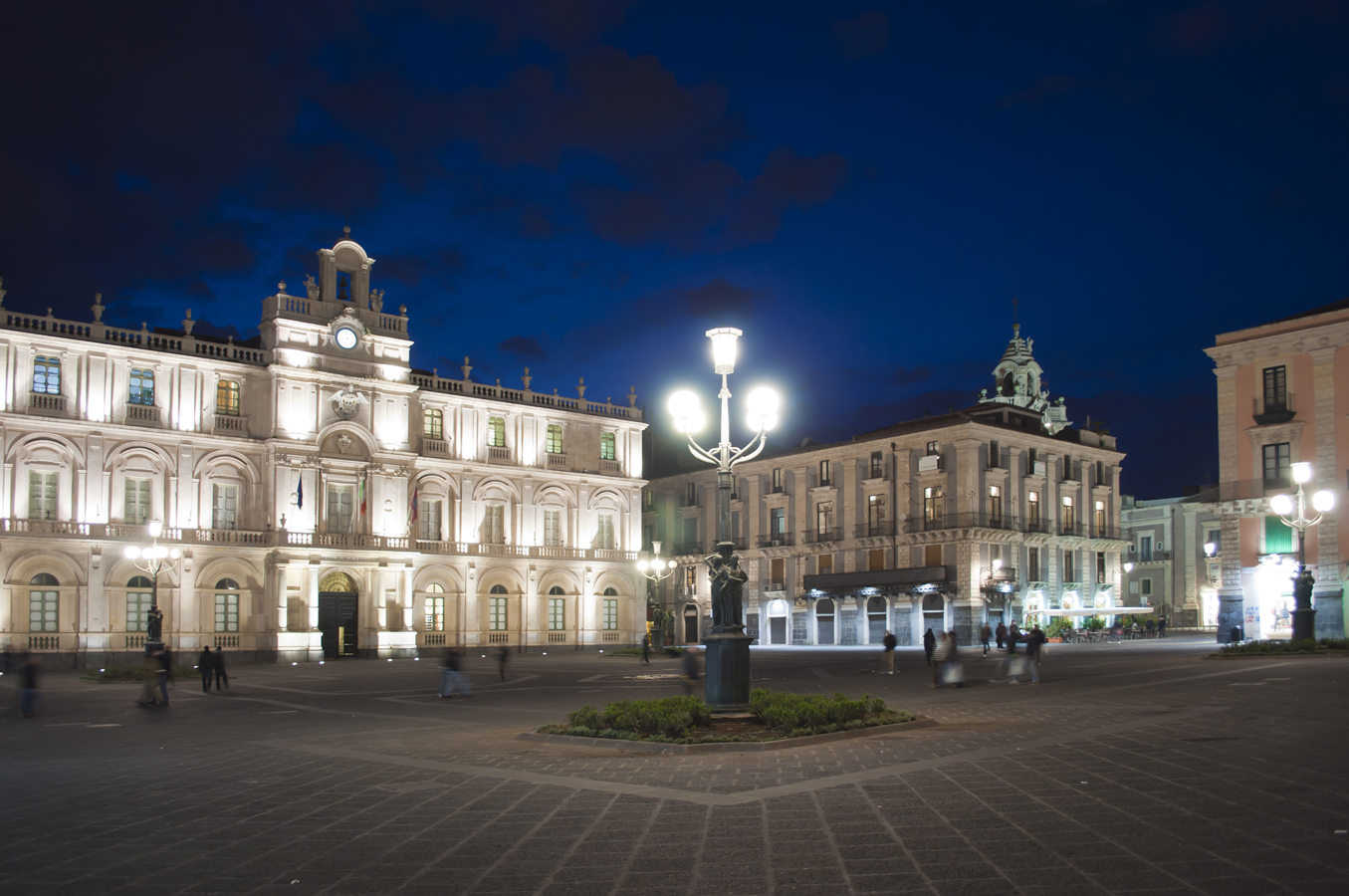
University square in Catania. Photo: Copyright © Sisterscom / Shutterstock
The entertainment offer is huge; there are theatres, night clubs, wine bars and many other places in modern, Arab, Japanese, Irish and Brazilian style. There are also many restaurants serving traditional local fare, rich in simple ingredients that are enhanced by imagination, perfumes and colours. Typical local coastal fish are the basis of many traditional recipes which are accompanied with wines from Mount Etna, both red and white.
The Etna
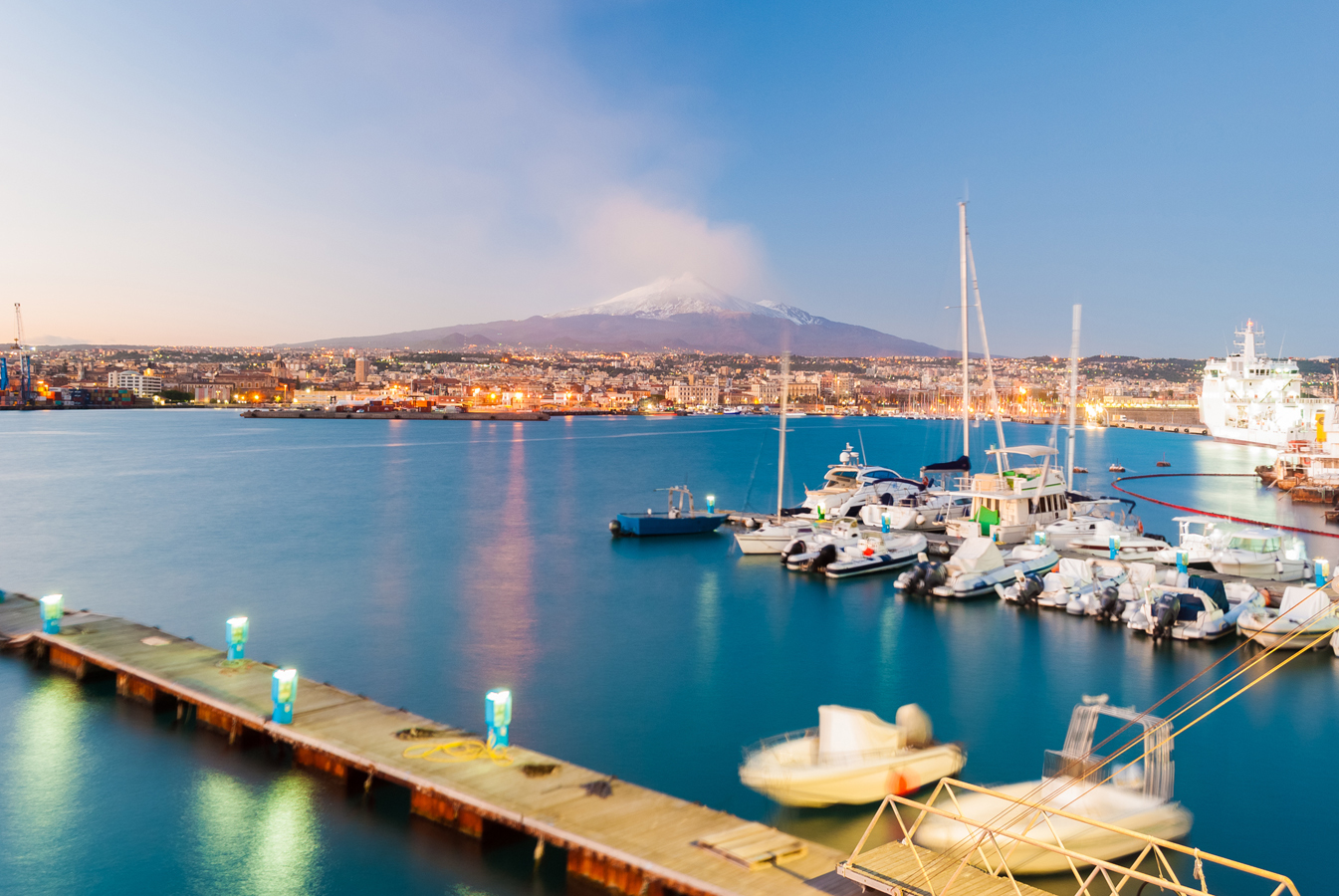
The Etna from the skyline of Catania. Photo: Copyright © Sisterscom / Shutterstock
And speaking of Etna… This enormous volcanic cone rises in the south of the Plain of Catania to an altitude of 3,300 metres. There are currently four different craters which are continuously active, pushing out gas, vapours and ash. The central crater, known as the "Voragine" (Abyss), is the largest of the four, with a diameter of over 500 metres. Today Etna is the largest active volcano in Europe, and offers spectacular and striking landscapes.
The dishes of the Catania cuisine
The most famous dish of the Catania tradition is pasta alla Norma, macaroni seasoned with fresh tomato sauce, crunchy fried aubergines, green basil and grated salted ricotta. Try the sardines a beccafico or with the onion, the fried meatballs (u muccu), the spaghetti with squid ink, the eggplant caponata, the eggplant parmigiana.
The typical Catanese breakfast is granita accompanied by the typical Sicilian brioche prepared with yeast-based dough and topped with a ball (called tuppu). The typical desserts are: the ricotta cannolo, composed of a crunchy wafer filled with ricotta cream and decorated with chocolate flakes and pistachio chips, stuffed at the time of tasting, the ricotta-based cassata and the Frutta Martorana based on almond flour and sugar.
The typical Catanese breakfast is granita accompanied by the typical Sicilian brioche prepared with yeast-based dough and topped with a ball (called tuppu). The typical desserts are: the ricotta cannolo, composed of a crunchy wafer filled with ricotta cream and decorated with chocolate flakes and pistachio chips, stuffed at the time of tasting, the ricotta-based cassata and the Frutta Martorana based on almond flour and sugar.
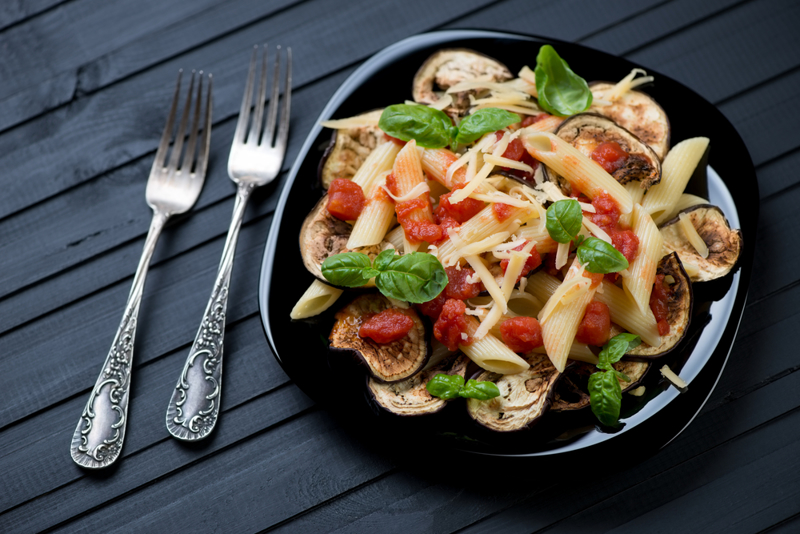
Pasta alla Norma

Melanzane alla parmigiana
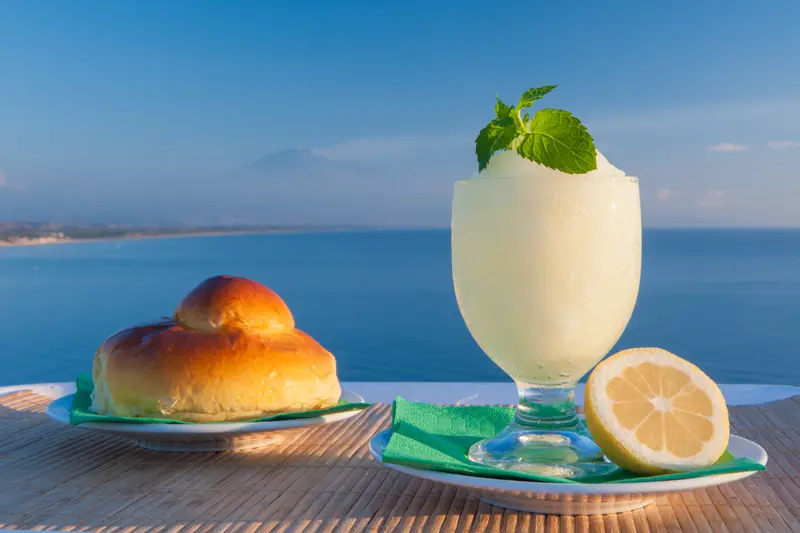
Granita siciliana
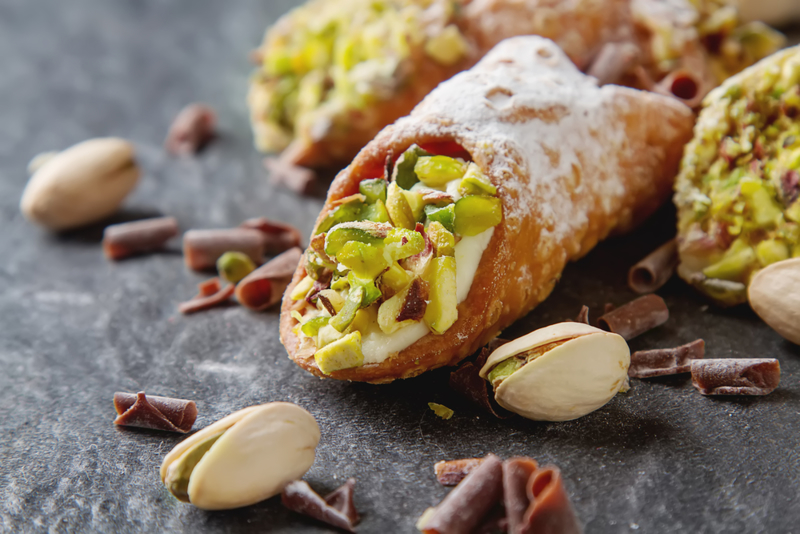
Cannolo siciliano
Text by Alisè Vitri
Avion Tourism Magazine
Photos: Sisterscom.com, Shutterstock
Photos: Sisterscom.com, Shutterstock
Copyright © Sisterscom.com
Video: www.visitsicily.info
Tourism Board
www.comune.catania.it
turismo.cittametropolitana.ct.it
www.visitsicily.info
Tourist Offices
Catania Airport, Tourist Office
Via Vittorio Emanuele 172, Catania, Tourist Office
Partnership with Booking.com
Where to sleep in Catania
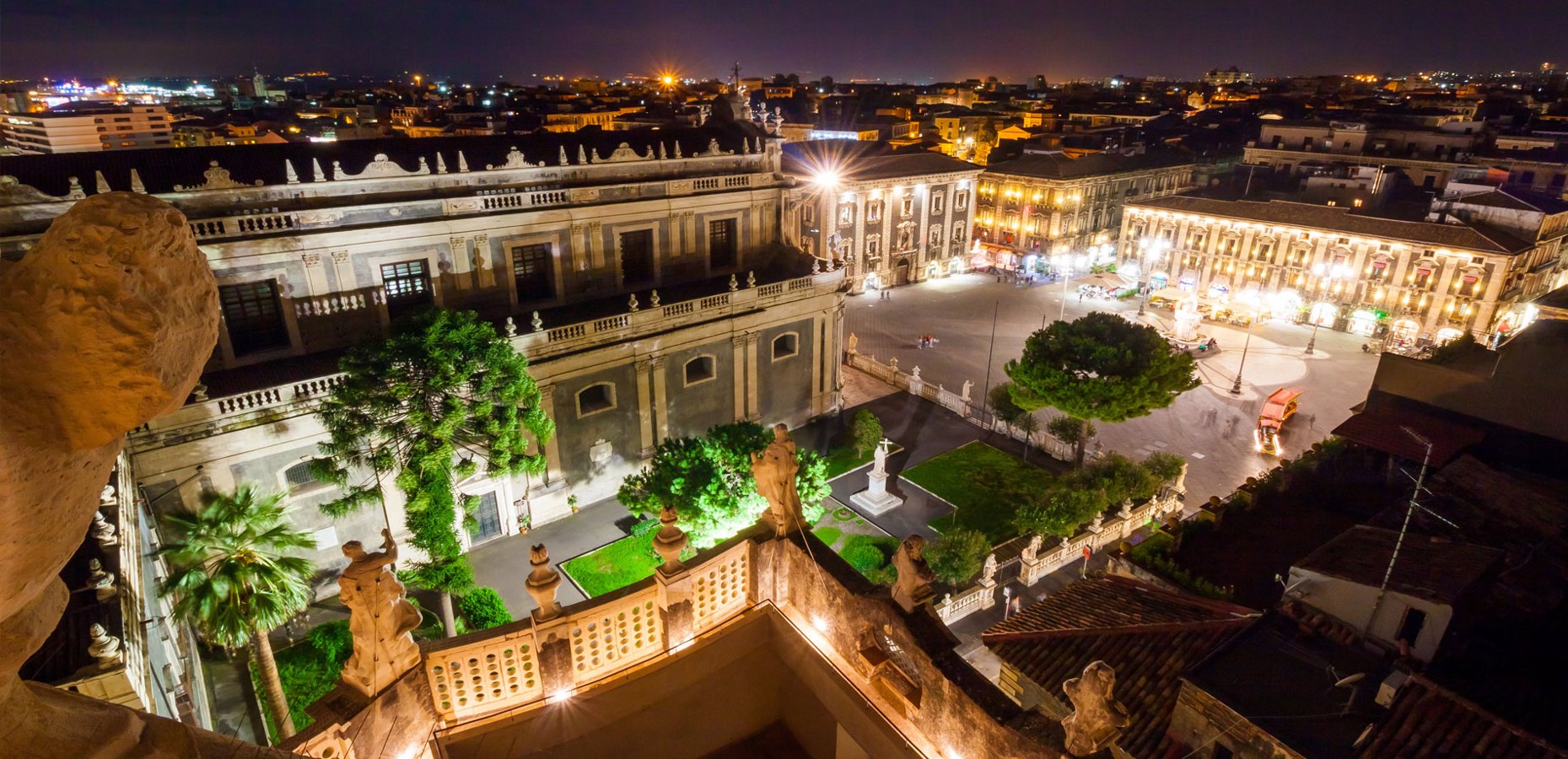
Catania. Foto: Copyright © Sisterscom / Shutterstock
Catania is a welcoming city and offers different possibilities for accommodation.
To find the ideal hotel and the best offers you can do a search for the stars but also for districts or landmarks.
DISTRICTS
Hotels in the districts
LANDMARKS
Hotels in tourist areas
WHERE TO GO in catania
Monuments in Catania
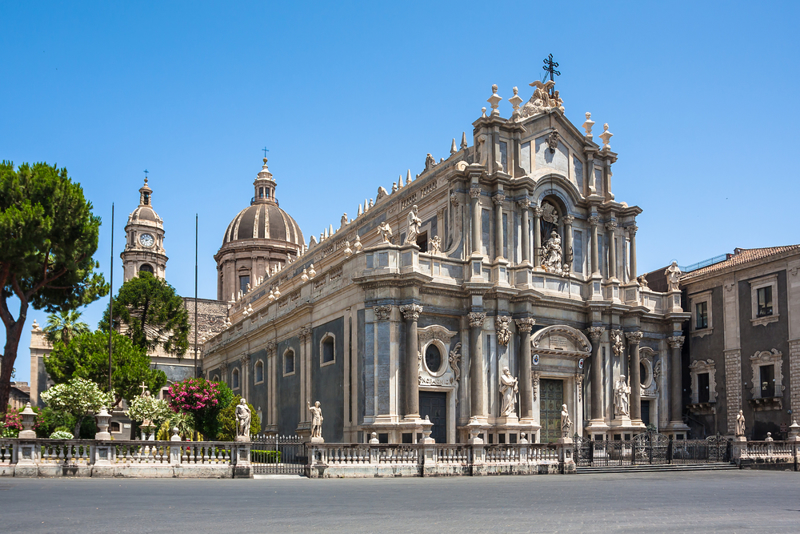
Copyright © Sisterscom / Shutterstock
CATHEDRAL OF CATANIA
The Cathedral stands on the late-Gothic Cathedral Square of Catania and was built after the earthquake of 1693 on the same site as the Norman Cathedral of 1092. The seventeenth-century reconstruction was curated by the architect Giovanni Battista Vaccarini. Of particular interest inside are the tomb of Vincenzo Bellini, a well-known musician from Catania, and the Chapel of St. Agatha, which holds the remains of the Patron Saint and can only be viewed on St. Agatha feast days.
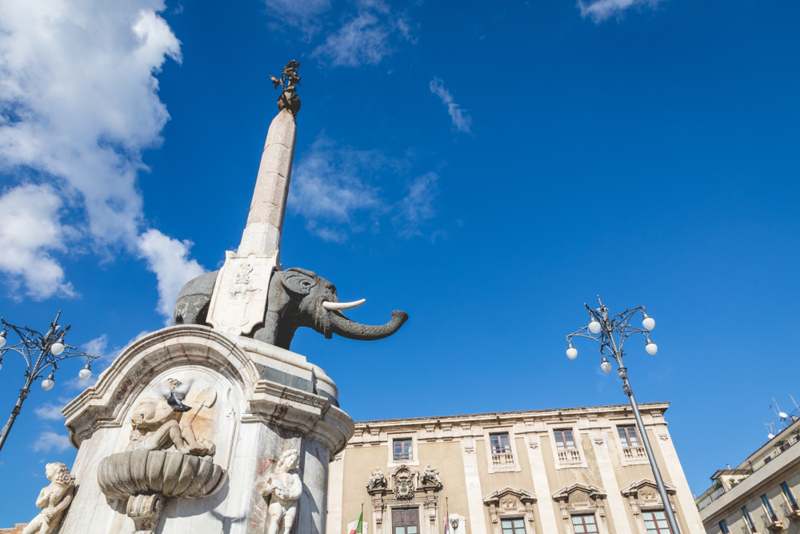
Copyright © Sisterscom / Shutterstock
ELEPHANT FOUNTAIN OF CATANIA
In the centre of Piazza Duomo (Cathedral Square) stands an elephant sculpted in volcanic rock, which is part of the monumental Elephant Fountain built between 1735 and 1737 by the architect Giovanni Battista Vaccarini. The elephant has its trunk facing St. Agatha Cathedral and a three-metre granite obelisk on its back. The elephant, a symbol of the city, is also found on the city’s crests, and is generally topped by St. Agatha warrior or by an “A”, her initial.
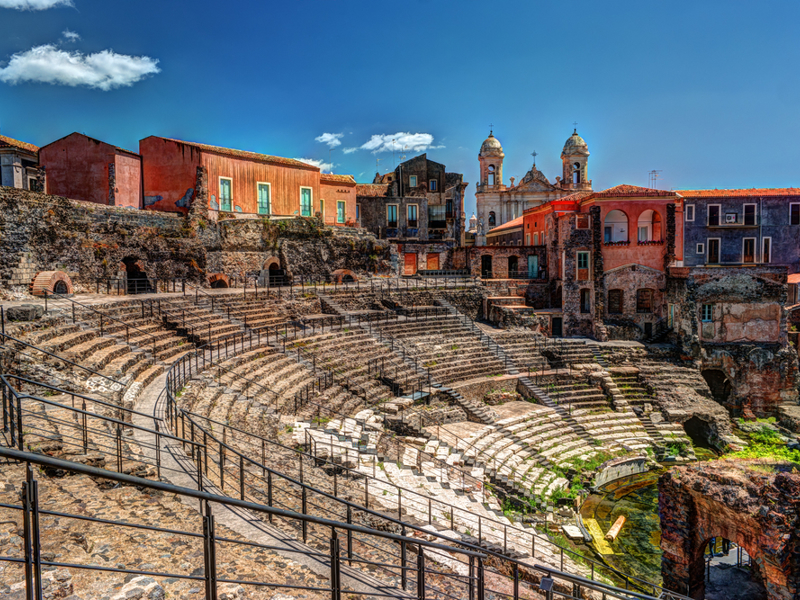
Copyright © Sisterscom / Shutterstock
ROMAN THEATRE
The ancient theater of Catania, leaning against a hill where the ancient acropolis of Catania once stood, could accommodate about 7,000 spectators. The tiers for spectators, with their limestone seats, were originally covered with marble slabs. The scene used for theatrical performances featured niches, columns and statues for decorative purposes.
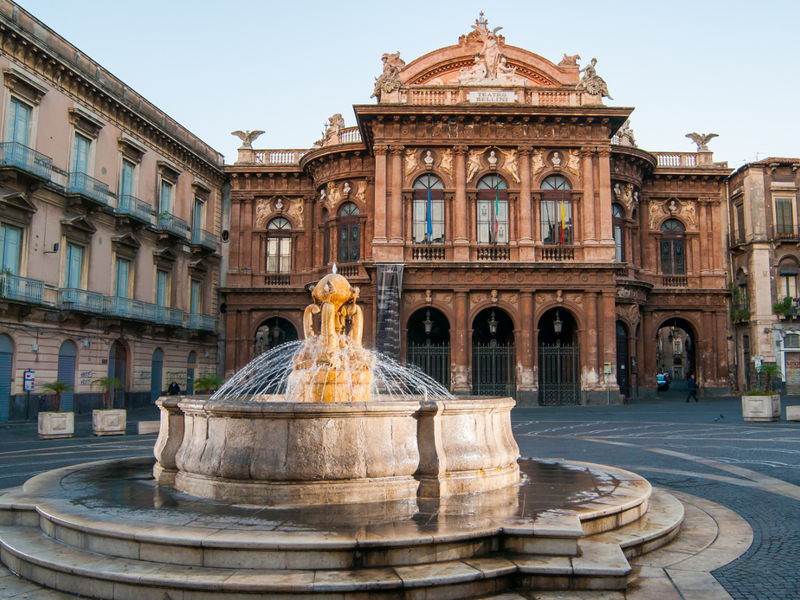
Copyright © Sisterscom / Shutterstock
BELLINI THEATRE OF CATANIA
The Bellini Theatre stands in the square of the same name and was inaugurated in 1890 with a performance of “Norma“ by Vincenzo Bellini. The current building, designed by the architect Carlo Sada, has an elegant entrance for carriages closed off by iron gates. The large hall inside features four rows of boxes and a balcony. The ceiling frescoes were painted by Ernesto Bellandi while the theatre curtains were painted by Giuseppe Sciuti in 1883.
www.teatromassimobellini.it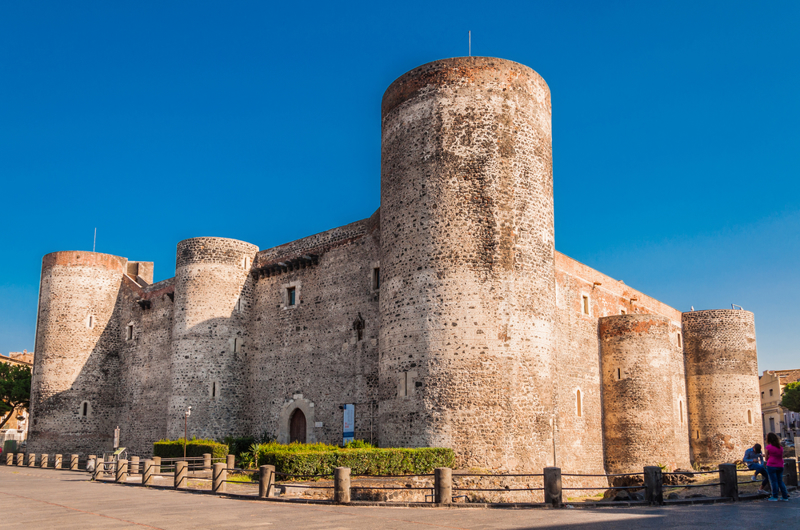
Copyright © Sisterscom / Shutterstock
URSINO CASTLE
Ursino Castle, built by Frederick II of Swabia between 1239 and 1250, houses the Civic Museum of Catania which displays collections such as those of the Prince of Biscari, and the Benedictine Fathers. The internal courtyard houses sarcophagi, columns, architectural fragments and obelisks recovered from Catania’s ancient monuments.
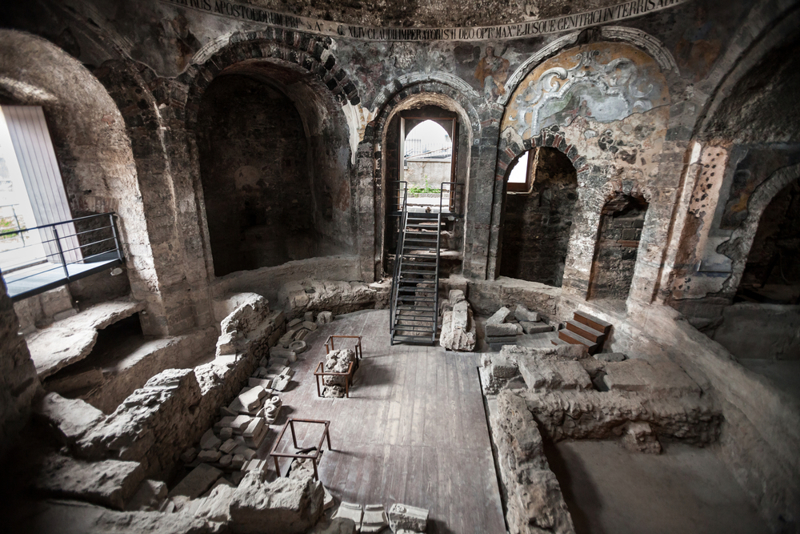
Copyright © Sisterscom / Shutterstock
TERME DELLA ROTONDA OF CATANIA
They are located north of the ancient theater, and the entrance is on the street of the same name. Maybe, this construction served as a model for the Pantheon in Rome. It is a circular building with a series of marble arches and basins, inside large niches. Under a floor there are the finds of ancient constructions.
Museums in Catania
BELLINI CIVIC MUSEUM
The Vincenzo Bellini Museum was inaugurated in 1930 and is located inside the eighteenth-century Gravina Cruylas building in Piazza San Francesco d’Assisi 3, where the musician Bellini was born in 1801. The museum tour follows the life of Bellini, beginning in the alcove where he was born and ending in the funeral room (in the former kitchen of the house). The signed musical manuscripts, a collection of pianos, the library and the multimedia room are all of particular interest.
GIOVANNI VERGA HOUSE-MUSEUM
Via S. Anna, 8
In the centre of Catania stands the house where Giovanni Verga lived and where he died in 1922. The nineteenth-century building, inherited from his mother, became a national monument in 1940 and a regional house-museum in 1991. After the entrance door, a staircase leads to the apartment of the writer. The most important room is the library, which has a table piled high with personal items and six bookcases containing over 2,500 of the writer’s books.
In the centre of Catania stands the house where Giovanni Verga lived and where he died in 1922. The nineteenth-century building, inherited from his mother, became a national monument in 1940 and a regional house-museum in 1991. After the entrance door, a staircase leads to the apartment of the writer. The most important room is the library, which has a table piled high with personal items and six bookcases containing over 2,500 of the writer’s books.
UNIVERSITY BOTANICAL MUSEUMS
Via Antonio Longo 19
These comprise two museums of particular scientific value: the Herbarium and the Botanical Garden. These museums were set up in the mid-1900s when the University, on the initiative of the Benedictine monk Francesco Tornabene, purchased part of the land that housed the garden. A Herbarium is found inside the building, which contains old and more recent collections. The garden is home to succulents and palms.
These comprise two museums of particular scientific value: the Herbarium and the Botanical Garden. These museums were set up in the mid-1900s when the University, on the initiative of the Benedictine monk Francesco Tornabene, purchased part of the land that housed the garden. A Herbarium is found inside the building, which contains old and more recent collections. The garden is home to succulents and palms.
Excursions in Catania
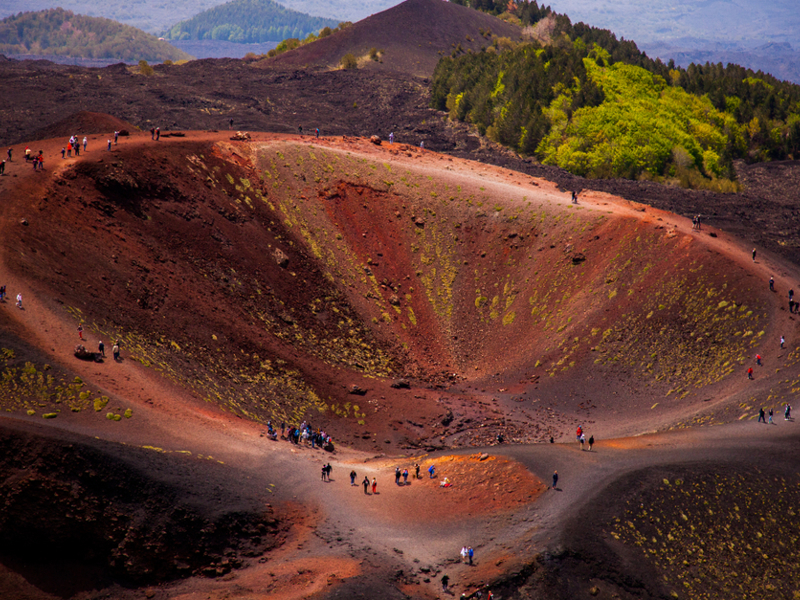
Copyright © Sisterscom / Shutterstock
ETNA PARK
Etna Park, established in 1987, is a nature reserve in Sicily in a protected area of 59,000 hectares. The area extends from the hills around Mount Etna, Europe’s highest active volcano, to the crater at the summit (3,350 m) and features a widely diverse range of fauna and vegetation. It is a UNESCO World Heritage Site. The park is divided in four zones and encompasses twenty municipalities in the Province of Catania.
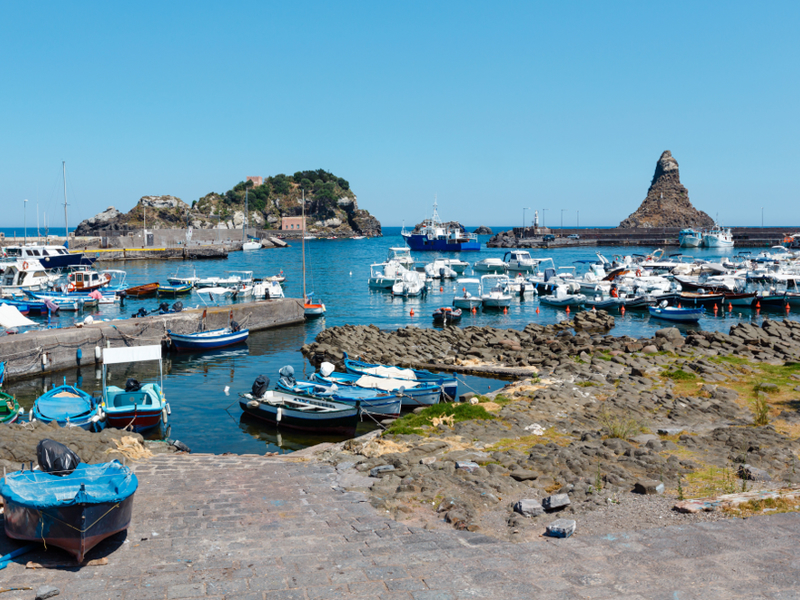
Copyright © Sisterscom / Shutterstock
LACHEA ISLAND and STACKS OF THE CYCLOPS
The Nature Reserve of Lachea Island and Stacks of the Cyclops was established in 1998. The Cyclops Archipelago is a site of natural-archaeological interest and the volcanic Lachea Island is the largest of the islands. The Cyclops Islands Protected Marine Area offers tours for nature lovers and diving off Lachea Island; it also offers a Marine Monitoring Station Museum with archaeological finds and a collection of marine and terrestrial fauna.
Partnership with GetYourGuide
Recommended tours in Catania
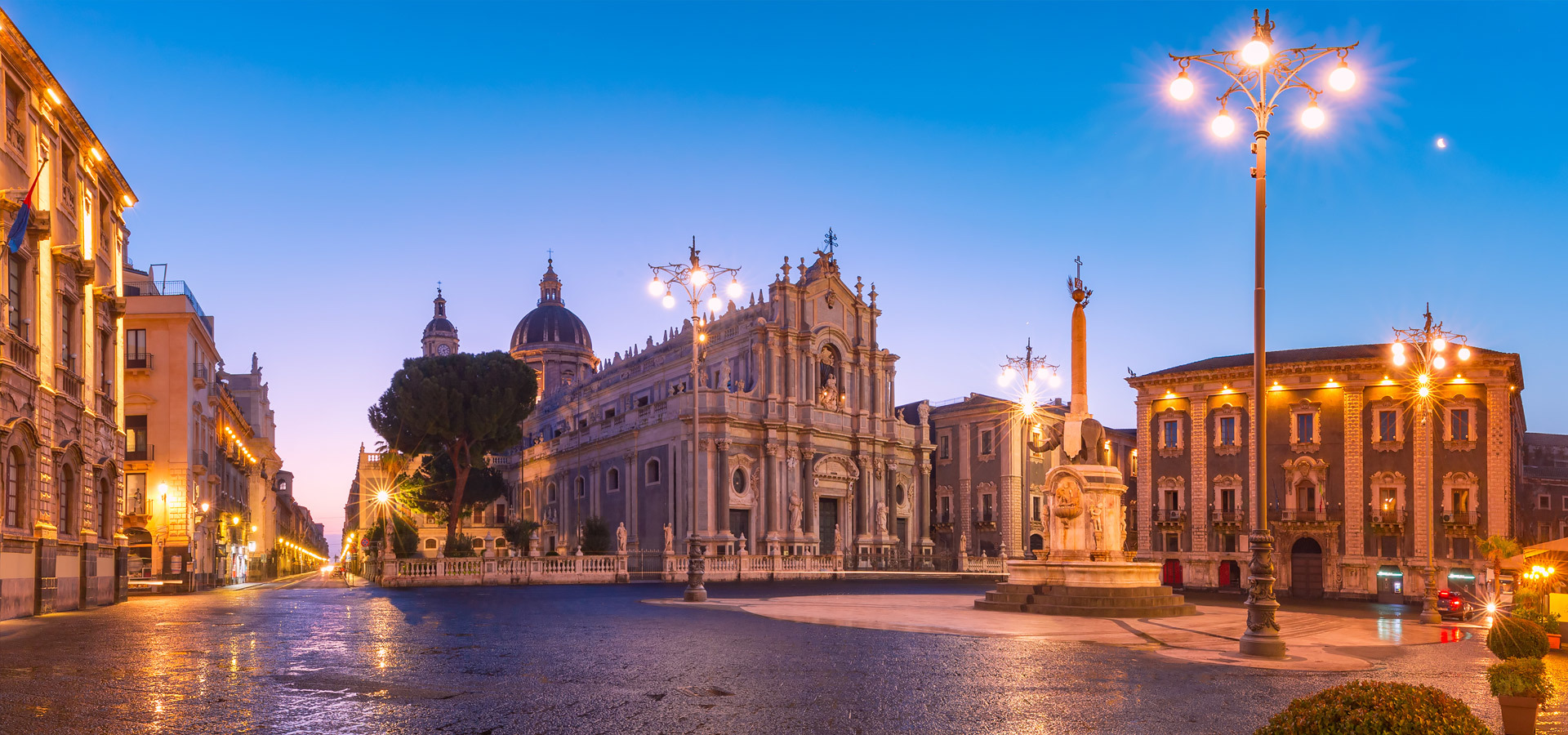
Copyright © Sisterscom / Shutterstock
CATANIA
A private tour to discover the main attractions of Catania: Piazza Stesicoro, the ruins of the Roman amphitheater, Via Etnea, Piazza Università, the Scalinata Alessi, Via dei Crociferi, the churches of the sixteenth century, Piazza San Francesco with its church, the monument dedicated to Cardinal Dusmet, Piazza Duomo with the cathedral and the town hall. Catania 2-Hour Private Walking Tour
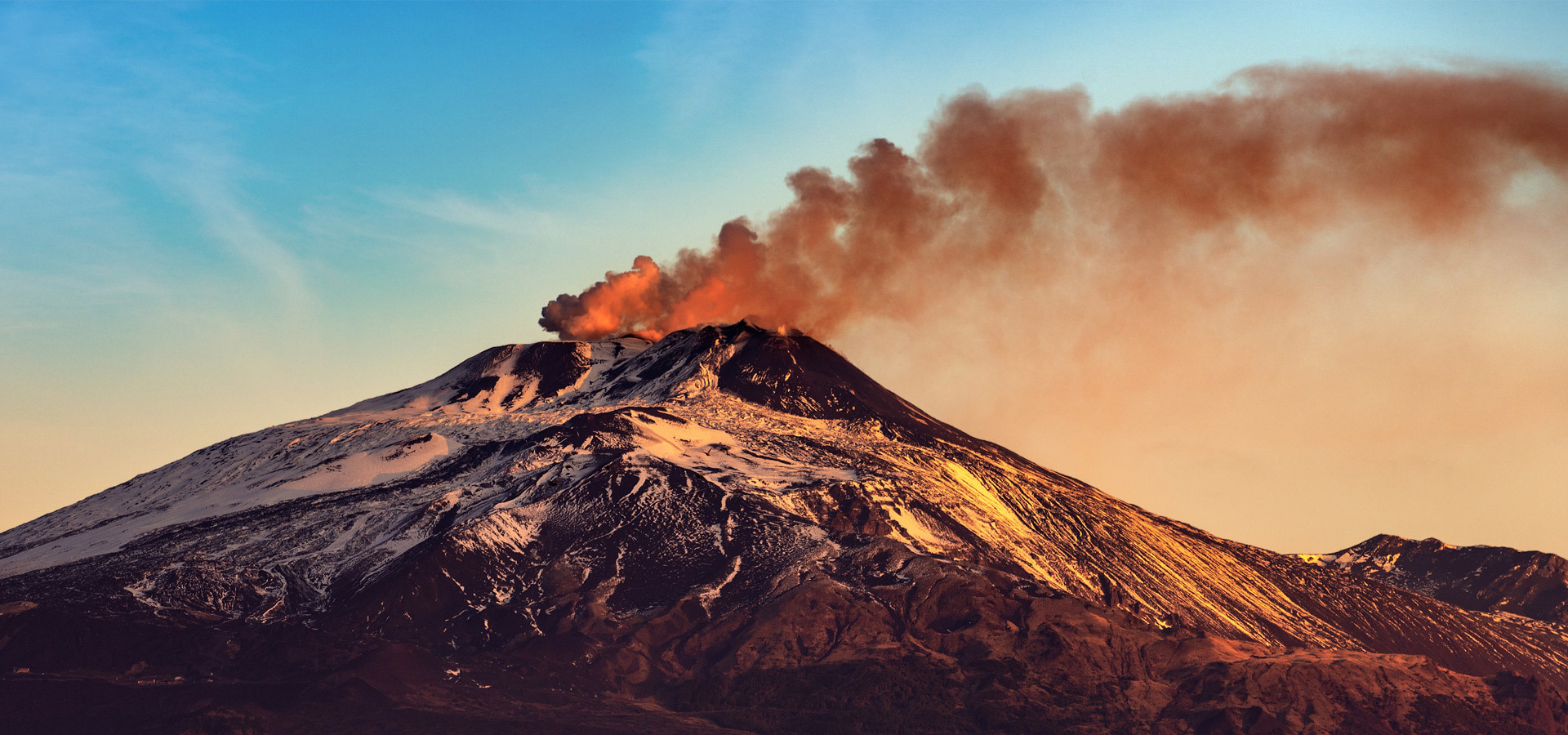
Copyright © Sisterscom / Shutterstock
ETNA
Excursion of 6-hour with guide from Catania by jeep or minivan to Mount Etna. At an altitude of 2000 meters, a guided walk through the ancient craters and the most recent lava flows. The tour then continues to explore a lava cave and a belvedere with the panorama of the Valle del Bove. Trekking is easy and suitable for everyone, including older participants and families with children. Etna in the morning: half day excursion from Catania
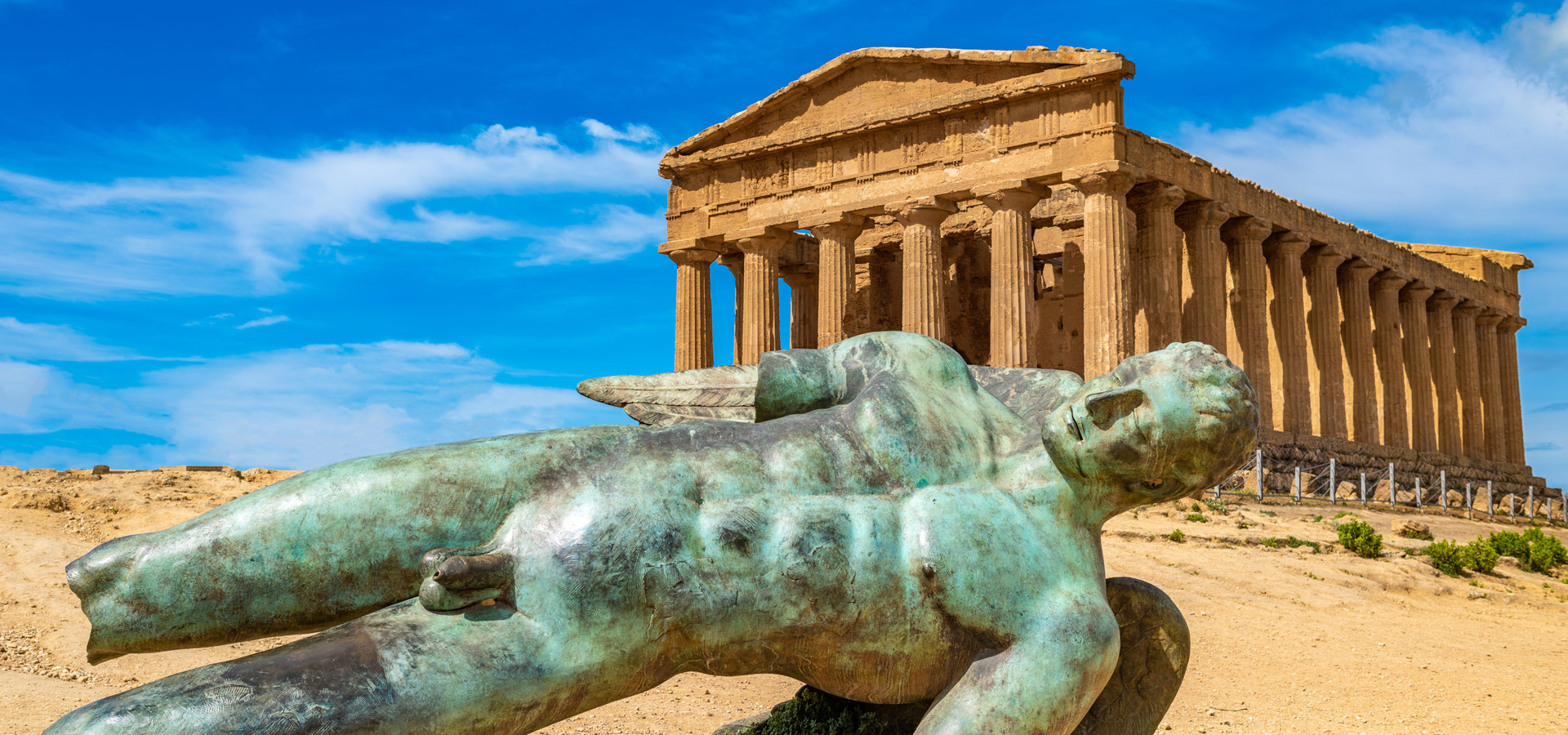
Copyright © Sisterscom / Shutterstock
AGRIGENTO and PIAZZA ARMERINA
The tour starts from Catania to Agrigento, known for the ruins of the ancient city of Akragas in the Valley of the Temples, which includes the Temple of Olympian Zeus, the Temple of Juno and the Temple of Concordia. Also 3 sanctuaries and the necropolises of Montelusa, Mosè and Pezzino. The tour then continues to Piazza Armerina in the Erei Mountains, to enchant the mosaics in the ruins of a Roman noble residence in the Villa del Casale. From Catania: Agrigento and Piazza Armerina full-day trip
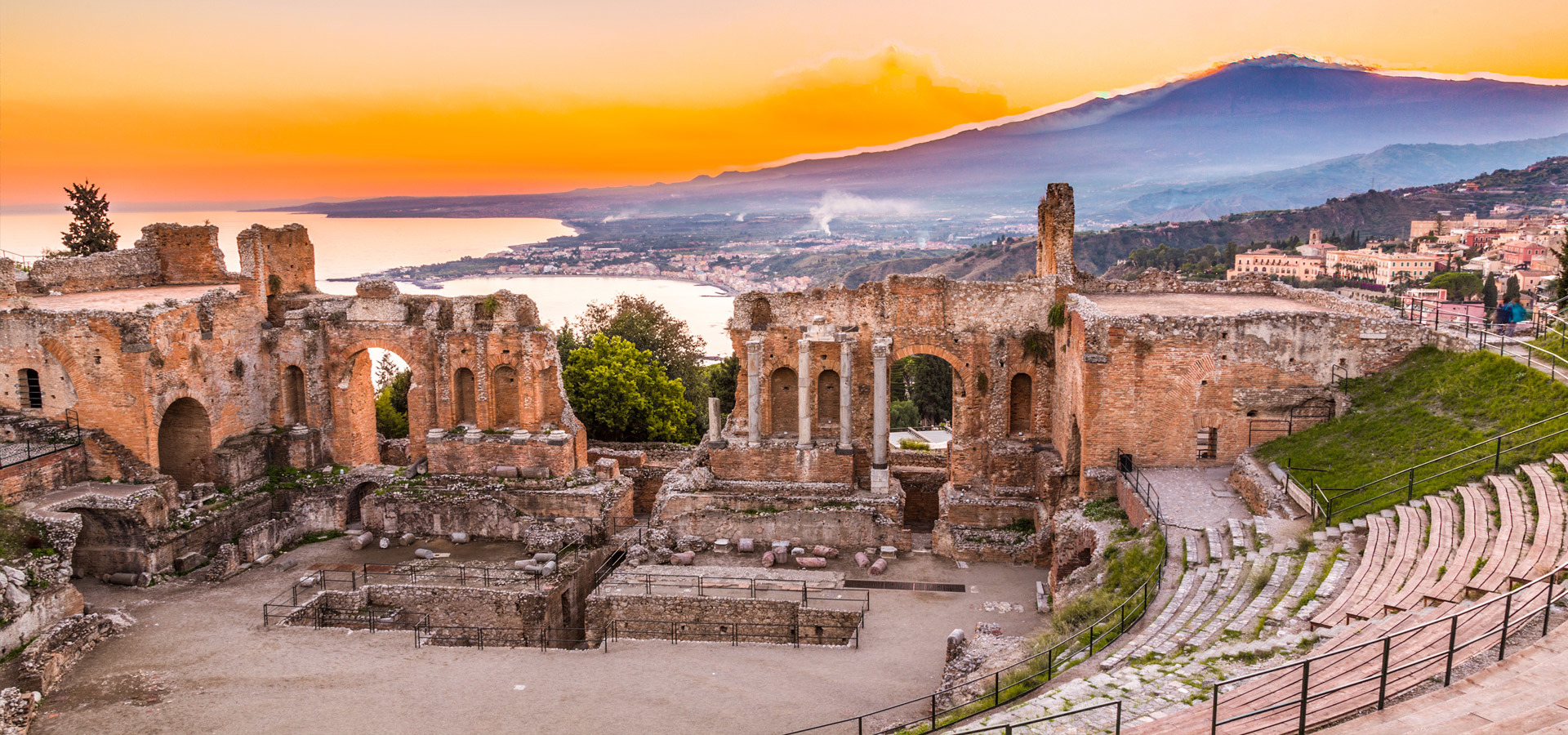
Copyright © Sisterscom / Shutterstock
MOUNT ETNA and TAORMINA
Tour in the territories of Mount Etna with shuttle bus. Starting from the Rifugio Sapienza, follow the line of the ancient Silvestri Craters up to the lava cave formed during the eruption of 1792, then you reach the province of Zafferana with a visit to a local organic farm to taste honey and wine. Before arriving in Taormina, stop in Isola Bella for a dip in the Blue Grotto. In Taormina, free lunch with a visit to the tourist attractions, from the Greek theater to the views of the Nexus Bay and the architecture of Palazzo Corvaja. From Catania: full-day Mount Etna and Taormina tour
News & Useful info
Shopping
Destinations found in the vicinity
Other destinations
Airports nearby Catania

